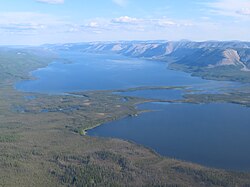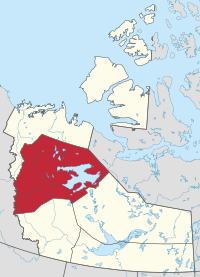Sahtu Region
Administrative region in Northwest Territories, Canada From Wikipedia, the free encyclopedia
Administrative region in Northwest Territories, Canada From Wikipedia, the free encyclopedia
The Sahtu Region is an administrative region in Canada's Northwest Territories. Coterminous with the settlement region described in the 1993 Sahtu Dene and Metis Comprehensive Land Claim Agreement, 41,437 km2 (15,999 sq mi) of the Sahtu is collectively owned by its Indigenous Sahtu (Dene) and Métis inhabitants. Although the region's population is predominantly First Nations, a significant non-Indigenous presence exists in Norman Wells, the regional office,[1] established in 1920 to serve the only producing oilfield in the Canadian Territories. Considered to be of vital strategic importance during World War II in the event of a Japanese invasion of Alaska, the region's petroleum resources were exploited by the United States Army with the Canol Project, but the pipeline never became necessary and ultimately operated for less than one year.

Sahtu Region | |
|---|---|
 Norman Range and Kelly Lake | |
 Location within the Northwest Territories | |
| Country | Canada |
| Territory | Northwest Territories |
| Territorial riding | Sahtu |
| Settlement area | Sahtu |
| Regional office[1] | Norman Wells |
| Population (2016) | |
| • Total | 2,554 |
| Time zone | UTC−07:00 (MST) |
| • Summer (DST) | UTC−06:00 (DST) |
Since the abandonment of the Canol project, development within the region has been more limited than in the rest of the territory. Although plans have long existed for pipelines and highways to parallel the Mackenzie River through the Sahtu en route to the Arctic Ocean, the landmark Mackenzie Valley Pipeline Inquiry recommended that a moratorium be placed on construction until local Indigenous land claims could be settled. To this day, no all-weather roads connect the Sahtu with the rest of Canada, and the contiguous North American pipeline network finds its northernmost terminus at Norman Wells, which was connected to Zama City, Alberta in 1984. Ground transportation is seasonally provided by a network of winter and ice roads, while the abandoned Canol route now forms part of the Trans Canada Trail system.[2]
Sahtú is the Dene name of Great Bear Lake, the largest lake entirely in Canada, which is entirely contained within the Sahtu Region. The name is also used by the area's First Nations inhabitants to describe themselves and their language, the Sahtú Dene people (historically known as the North Slavey or Hareskins).[3] It has been further adopted by the Sahtu Dene Council and the Sahtu Secretariat, both Indigenous institutions which share administrative responsibilities with the Government of the Northwest Territories within the region.
The Sahtu Region consists of five communities, with no permanent population recorded outside their boundaries. Norman Wells, the regional capital, was founded in the early 20th century in order to exploit local oil deposits and has a majority non-Indigenous population. The other communities of the Sahtu are predominantly First Nations.
| Community | Demographics (2021) | |||||||
|---|---|---|---|---|---|---|---|---|
| Name[4] | Type[5] | Census[6] | Indigenous population profile[7] | |||||
| Official | Traditional | Total | % change | First Nations | Métis | Inuit | Other | |
| Colville Lake | K'áhbamı̨́túé | Settlement Corporation | 110 | -14.7% | 105 | 0 | 0 | 0 |
| Délı̨nę | Délı̨ne | Charter Community | 573 | 7.5% | 495 | 10 | 10 | 45 |
| Fort Good Hope | Rádeyı̨lı̨kóé | Charter Community | 507 | -1.7% | 435 | 15 | 10 | 40 |
| Norman Wells | Tłegǫ́htı̨ | Town | 673 | -13.5% | 175 | 80 | 20 | 375 |
| Tulita | Tulı́t’a | Hamlet | 396 | -17% | 320 | 40 | 10 | 30 |
|
| ||||||||||||||||||||||||||||||||||||||||||||||||||||||||||||
| Sources: NWT Bureau of Statistics (2001 - 2017)[8][6] | |||||||||||||||||||||||||||||||||||||||||||||||||||||||||||||
| Climate data for Norman Wells (Norman Wells Airport) WMO ID: 71043; coordinates 65°16′53″N 126°47′55″W; elevation: 72.5 m (238 ft); 1991–2020 normals, extremes 1943–present | |||||||||||||
|---|---|---|---|---|---|---|---|---|---|---|---|---|---|
| Month | Jan | Feb | Mar | Apr | May | Jun | Jul | Aug | Sep | Oct | Nov | Dec | Year |
| Record high humidex | 12.2 | 6.3 | 17.5 | 20.0 | 29.7 | 36.2 | 37.2 | 36.0 | 29.7 | 19.8 | 12.2 | 10.7 | 37.2 |
| Record high °C (°F) | 12.5 (54.5) |
7.9 (46.2) |
17.8 (64.0) |
20.0 (68.0) |
31.3 (88.3) |
33.5 (92.3) |
37.9 (100.2) |
34.8 (94.6) |
28.7 (83.7) |
21.0 (69.8) |
13.3 (55.9) |
11.1 (52.0) |
37.9 (100.2) |
| Mean daily maximum °C (°F) | −21.4 (−6.5) |
−18.0 (−0.4) |
−12.0 (10.4) |
0.9 (33.6) |
13.0 (55.4) |
21.0 (69.8) |
22.6 (72.7) |
19.1 (66.4) |
11.3 (52.3) |
−0.5 (31.1) |
−13.6 (7.5) |
−19.6 (−3.3) |
0.2 (32.4) |
| Daily mean °C (°F) | −25.4 (−13.7) |
−22.8 (−9.0) |
−18.2 (−0.8) |
−5.3 (22.5) |
6.9 (44.4) |
15.0 (59.0) |
16.8 (62.2) |
13.7 (56.7) |
6.5 (43.7) |
−3.9 (25.0) |
−17.4 (0.7) |
−23.6 (−10.5) |
−4.8 (23.4) |
| Mean daily minimum °C (°F) | −29.4 (−20.9) |
−27.5 (−17.5) |
−24.3 (−11.7) |
−11.5 (11.3) |
0.8 (33.4) |
8.8 (47.8) |
10.9 (51.6) |
8.2 (46.8) |
1.5 (34.7) |
−7.2 (19.0) |
−21.2 (−6.2) |
−27.5 (−17.5) |
−9.9 (14.2) |
| Record low °C (°F) | −52.2 (−62.0) |
−54.4 (−65.9) |
−46.1 (−51.0) |
−37.2 (−35.0) |
−17.8 (0.0) |
−4.3 (24.3) |
−1.1 (30.0) |
−6.1 (21.0) |
−15.7 (3.7) |
−31.7 (−25.1) |
−42.8 (−45.0) |
−47.8 (−54.0) |
−54.4 (−65.9) |
| Record low wind chill | −61.7 | −60.2 | −57.5 | −43.8 | −25.1 | −6.9 | −2.2 | −9.6 | −17.7 | −39.9 | −52.4 | −62.4 | −62.4 |
| Average precipitation mm (inches) | 18.0 (0.71) |
17.2 (0.68) |
11.3 (0.44) |
11.1 (0.44) |
20.5 (0.81) |
35.8 (1.41) |
49.0 (1.93) |
52.5 (2.07) |
33.9 (1.33) |
23.5 (0.93) |
27.2 (1.07) |
21.6 (0.85) |
321.6 (12.66) |
| Average rainfall mm (inches) | 0.2 (0.01) |
0.0 (0.0) |
0.4 (0.02) |
1.3 (0.05) |
11.6 (0.46) |
35.7 (1.41) |
46.4 (1.83) |
49.1 (1.93) |
23.9 (0.94) |
3.3 (0.13) |
0.1 (0.00) |
0.0 (0.0) |
171.9 (6.77) |
| Average snowfall cm (inches) | 22.7 (8.9) |
21.7 (8.5) |
15.8 (6.2) |
14.2 (5.6) |
7.5 (3.0) |
0.4 (0.2) |
0.0 (0.0) |
0.1 (0.0) |
6.4 (2.5) |
24.8 (9.8) |
27.5 (10.8) |
24.8 (9.8) |
165.8 (65.3) |
| Average precipitation days (≥ 0.2 mm) | 12.8 | 11.9 | 10.9 | 7.4 | 8.3 | 10.7 | 13.5 | 14.8 | 13.4 | 14.2 | 15.4 | 14.1 | 147.3 |
| Average rainy days (≥ 0.2 mm) | 0.17 | 0.04 | 0.21 | 0.92 | 4.8 | 9.6 | 12.0 | 12.1 | 9.9 | 2.5 | 0.22 | 0.0 | 52.4 |
| Average snowy days (≥ 0.2 cm) | 11.8 | 11.3 | 10.5 | 6.7 | 3.1 | 0.16 | 0.0 | 0.08 | 3.3 | 12.4 | 13.6 | 12.4 | 85.3 |
| Average relative humidity (%) (at 1500 LST) | 67.1 | 62.5 | 53.0 | 50.8 | 45.2 | 44.2 | 50.2 | 56.2 | 61.5 | 75.3 | 75.0 | 69.6 | 59.2 |
| Source: Environment and Climate Change Canada (1991-2020 climate normals)[9] (July Maximum temperature)[10] | |||||||||||||
| Climate data for Délı̨nę (Déline Airport) Climate ID: 214274; coordinates 65°12′40″N 123°26′10″W; elevation: 214.0 m (702.1 ft); 1981–2010 normals. | |||||||||||||
|---|---|---|---|---|---|---|---|---|---|---|---|---|---|
| Month | Jan | Feb | Mar | Apr | May | Jun | Jul | Aug | Sep | Oct | Nov | Dec | Year |
| Record high humidex | 2.8 | 0.5 | 3.8 | 16.6 | 22.8 | 29.8 | 33.5 | 31.8 | 22.9 | 20.5 | 2.4 | 0.3 | 33.5 |
| Record high °C (°F) | 2.5 (36.5) |
1.0 (33.8) |
4.0 (39.2) |
16.0 (60.8) |
22.5 (72.5) |
29.3 (84.7) |
31.2 (88.2) |
32.0 (89.6) |
23.5 (74.3) |
20.8 (69.4) |
4.8 (40.6) |
3.3 (37.9) |
32.0 (89.6) |
| Mean daily maximum °C (°F) | −20.9 (−5.6) |
−18.5 (−1.3) |
−13.9 (7.0) |
−1.9 (28.6) |
7.4 (45.3) |
16.8 (62.2) |
19.4 (66.9) |
16.6 (61.9) |
10.2 (50.4) |
−0.8 (30.6) |
−11.5 (11.3) |
−17.6 (0.3) |
−1.2 (29.8) |
| Daily mean °C (°F) | −25.0 (−13.0) |
−23.2 (−9.8) |
−19.5 (−3.1) |
−7.7 (18.1) |
2.5 (36.5) |
10.7 (51.3) |
13.3 (55.9) |
11.2 (52.2) |
5.7 (42.3) |
−3.9 (25.0) |
−15.4 (4.3) |
−22.0 (−7.6) |
−6.1 (21.0) |
| Mean daily minimum °C (°F) | −28.9 (−20.0) |
−27.8 (−18.0) |
−25.1 (−13.2) |
−13.6 (7.5) |
−2.5 (27.5) |
4.4 (39.9) |
7.2 (45.0) |
5.8 (42.4) |
1.3 (34.3) |
−7.0 (19.4) |
−19.2 (−2.6) |
−26.3 (−15.3) |
−11.0 (12.2) |
| Record low °C (°F) | −49.1 (−56.4) |
−43.3 (−45.9) |
−43.3 (−45.9) |
−35.0 (−31.0) |
−23.3 (−9.9) |
−4.0 (24.8) |
−1.8 (28.8) |
−4.9 (23.2) |
−13.3 (8.1) |
−29.7 (−21.5) |
−37.4 (−35.3) |
−43.0 (−45.4) |
−49.1 (−56.4) |
| Record low wind chill | −57.2 | −54.0 | −55.3 | −40.4 | −27.6 | −6.4 | 0.0 | −3.6 | −16.3 | −34.4 | −46.7 | −54.7 | −57.2 |
| Average precipitation mm (inches) | 10.3 (0.41) |
11.2 (0.44) |
10.3 (0.41) |
10.1 (0.40) |
14.8 (0.58) |
24.3 (0.96) |
40.3 (1.59) |
43.2 (1.70) |
39.5 (1.56) |
31.1 (1.22) |
21.7 (0.85) |
11.9 (0.47) |
268.7 (10.58) |
| Average rainfall mm (inches) | 0.0 (0.0) |
0.0 (0.0) |
0.0 (0.0) |
0.1 (0.00) |
12.2 (0.48) |
24.2 (0.95) |
40.3 (1.59) |
43.2 (1.70) |
37.1 (1.46) |
4.9 (0.19) |
0.4 (0.02) |
0.0 (0.0) |
162.3 (6.39) |
| Average snowfall cm (inches) | 13.0 (5.1) |
16.9 (6.7) |
17.1 (6.7) |
12.3 (4.8) |
3.4 (1.3) |
0.2 (0.1) |
0.0 (0.0) |
0.0 (0.0) |
2.4 (0.9) |
32.2 (12.7) |
35.2 (13.9) |
17.3 (6.8) |
150.0 (59.1) |
| Average precipitation days (≥ 0.2 mm) | 5.4 | 6.8 | 7.5 | 3.9 | 6.1 | 8.0 | 10.4 | 12.3 | 12.4 | 12.4 | 10.1 | 7.2 | 102.4 |
| Average rainy days (≥ 0.2 mm) | 0.0 | 0.0 | 0.0 | 0.2 | 4.5 | 8.0 | 10.4 | 12.3 | 11.8 | 2.4 | 0.1 | 0.0 | 49.7 |
| Average snowy days (≥ 0.2 cm) | 6.7 | 7.5 | 9.4 | 4.2 | 1.7 | 0.1 | 0.0 | 0.0 | 0.9 | 10.5 | 11.4 | 8.9 | 61.4 |
| Average relative humidity (%) | 74.9 | 76.1 | 76.7 | 75.0 | 63.0 | 54.5 | 58.2 | 62.1 | 65.7 | 82.6 | 82.5 | 76.1 | 70.6 |
| Source: Environment and Climate Change Canada[11][12] | |||||||||||||
Seamless Wikipedia browsing. On steroids.
Every time you click a link to Wikipedia, Wiktionary or Wikiquote in your browser's search results, it will show the modern Wikiwand interface.
Wikiwand extension is a five stars, simple, with minimum permission required to keep your browsing private, safe and transparent.